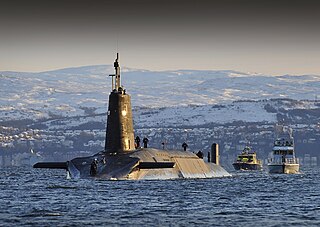
The BGM-109 TomahawkLand Attack Missile (TLAM) is an American long-range, all-weather, jet-powered, subsonic cruise missile that is primarily used by the United States Navy and Royal Navy in ship and submarine-based land-attack operations.

The Swiftsure class was a class of nuclear-powered fleet submarines in service with the Royal Navy from the early 1970s until 2010.

The Trafalgar class is a class of nuclear-powered fleet submarines (SSNs) in service with the Royal Navy, and the successor to the Swiftsure class. Like the majority of Royal Navy nuclear submarines, all seven boats were constructed at Barrow-in-Furness shipyard, Cumbria. With only one boat remaining active and in commission and six retired from the seven originally in service, the class makes up part of the Royal Navy's nuclear-powered ‘hunter-killer’ submarine force. The Trafalgar class has nearly been replaced by the larger and more capable Astute class, of which five are commissioned.

The Vanguard class is a class of nuclear-powered ballistic missile submarines (SSBNs) in service with the Royal Navy. The class was introduced in 1994 as part of the Trident nuclear programme, and comprises four vessels: Vanguard, Victorious, Vigilant and Vengeance, built between 1986 and 1999 at Barrow-in-Furness by Vickers Shipbuilding and Engineering, now owned by BAE Systems. All four boats are based at HM Naval Base Clyde , 40 km (25 mi) west of Glasgow, Scotland.

HMS Astute is an operational nuclear-powered attack submarine in the Royal Navy, the lead boat of her class.

The Astute class is the latest class of nuclear-powered fleet submarines (SSNs) in service with the Royal Navy. The boats are being constructed by BAE Systems Submarines at Barrow-in-Furness. Seven boats will be constructed: the first of class, Astute, was launched by Camilla, Duchess of Cornwall, in 2007, commissioned in 2010, and declared fully operational in May 2014. The Astute class is the replacement for the Trafalgar-class fleet submarines in Royal Navy service.

HMS Triumph is a Trafalgar-class nuclear submarine of the Royal Navy and was the seventh and final boat of her class. She is the nineteenth nuclear-powered hunter-killer submarine built for the Royal Navy. Triumph is the tenth vessel, and the second submarine, to bear the name. The first HMS Triumph was a 68-gun galleon built in 1561. As of 2022, she is the last boat of her class remaining in service.

HMS Ambush is an Astute-class nuclear-powered attack submarine of the Royal Navy, the second boat of her class.
HMS Artful is the third Astute-class nuclear-powered fleet submarine of the British Royal Navy. She is the second submarine of the Royal Navy to bear this name. Artful was ordered from GEC's Marconi Marine on 17 March 1997, and was constructed at Barrow in Furness. She was named on 20 September 2013, was rolled out of the shipyard construction hall on 16 May 2014, and was due to start sea trials in early 2015. Artful made her first successful basin dive in October 2014, and sailed on 13 August 2015 for sea trials. Artful was handed over the Royal Navy on 14 December 2015, and commissioned on 18 March 2016.
The Rolls-Royce pressurised water reactor (PWR) series has powered the Royal Navy's nuclear submarines since the Valiant class, commissioned in 1966.

Future planning of the Royal Navy's capabilities is set through periodic Defence Reviews carried out by the British Government.

His Majesty's Naval Base, Clyde, primarily sited at Faslane on the Gare Loch, is one of three operating bases in the United Kingdom for the Royal Navy. It is the navy's headquarters in Scotland and is best known as the home of Britain's nuclear weapons, in the form of nuclear submarines armed with Trident missiles.

BAE Systems Submarines, is a wholly owned subsidiary of BAE Systems, based in Barrow-in-Furness, Cumbria, England, and is responsible for the development and production of submarines.

The Royal Navy Submarine Service is one of the five fighting arms of the Royal Navy. It is sometimes known as the Silent Service, as submarines are generally required to operate undetected.

The Dreadnought class is the future replacement for the Royal Navy's Vanguard class of ballistic missile submarines. Like their predecessors they will carry Trident II D-5 missiles. The Vanguard submarines entered service in the United Kingdom in the 1990s with an intended service life of 25 years. Their replacement is necessary for maintaining a continuous at-sea deterrent (CASD), the principle of operation behind the Trident system.

HMS Audacious is the fourth Astute-class nuclear-powered fleet submarine of the Royal Navy. Several previous vessels of the Royal Navy have borne the name. She was formally named on 16 December 2016 and was launched on 28 April 2017. Audacious was stated to be handed over in January 2021. A parliamentary written answer stated that Audacious was commissioned on 3 April 2020, but her public ceremonial commissioning took place on 23 September 2021.

HMS Anson is the fifth Astute-class nuclear-powered fleet submarine of the Royal Navy. She is the eighth vessel of the Royal Navy to bear the name, after Admiral George Anson.

HMS Agamemnon is the sixth Astute-class nuclear-powered fleet submarine of the Royal Navy and is currently under construction. She will be the sixth vessel of the Royal Navy to bear the name, after the legendary Greek king Agamemnon.

This is a list of Active Royal Navy weapon systems.

The SSN-AUKUS, also known as the SSN-A, is a planned class of nuclear-powered fleet submarine (SSN) intended to enter service with the United Kingdom's Royal Navy in the late 2030s and Royal Australian Navy in the early 2040s. The class will replace the UK's Astute-class and Australia's Collins-class submarines.

















